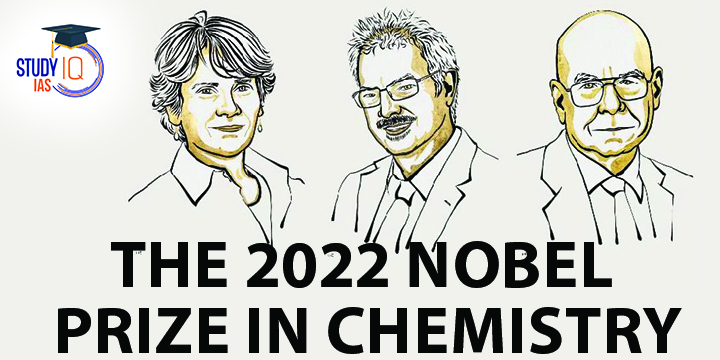Table of Contents
Nobel Prize in Chemistry: Background
- Ever since the birth of modern chemistry in the eighteenth century, many chemists have used nature as their role model for creating complex molecules especially for pharmaceutical research.
- However, one challenging problem is that complex molecules are built in many steps, with each step creating unwanted by-products, making the process time consuming and very expensive to produce.
- The Nobel Prize in Chemistry 2022 is all about finding new chemical ideals and letting simplicity and functionality take precedence.

Nobel Prize in Chemistry: Major Highlights of their Research
- The work of Barry Sharpless: He coined the concept of click chemistry, which is a form of simple and reliable chemistry, where reactions occur quickly, and unwanted by-products are avoided.
- The work of Morten Meldal: He along with Barry Sharpless – independent of each other – discovered a reaction known as the crown jewel of click chemistry: the copper catalyzed azide-alkyne cycloaddition (CuAAC).
- This is an efficient and straightforward chemical reaction. It is now in widespread use.
- Among many other uses, it is utilized in the development of pharmaceuticals, for mapping DNA and creating materials that are more fit for purpose.
- The work of Carolyn Bertozzi: She took the click chemistry to a whole new level by developing click reactions that work inside living organisms without disrupting the normal chemistry of the cell – what are now known as bio-orthogonal reactions.
- The problem with the CuAAC reaction is that copper is toxic to living beings. To solve this, in 2004, Carolyn discovered the copper-free click reaction, called the strain-promoted alkyne-azide cycloaddition (SPAAC).
- Bioorthogonal reactions are now used globally to explore cells and track biological processes.
- Using these reactions, researchers have improved the targeting of cancer pharmaceuticals, which are now being tested in clinical trials.
Nobel Prize in Chemistry: What is Click Chemistry?
- Click chemistry refers to a collection of organic reactions that proceed rapidly and selectively under mild conditions to covalently link molecular components.
- Click reaction uses only readily available reagents and is insensitive to oxygen and water. This aspect makes it widely acceptable.
- Applications of Click Chemistry:
- Drug discovery: Click chemistry has found increasing applications in all aspects of drug discovery in medicinal chemistry, such as for generating lead compounds through combinatorial methods.
- Bioconjugation: Click chemistry is rigorously employed in proteomics and nucleic research via bioconjugation.
- Radiochemistry: In radiochemistry, selective radiolabeling of biomolecules in cells and living organisms for imaging and therapy has been realized by click reactions.
- Nanoparticle modification: Click chemistry is generally used to conjugate the ligands, folate groups to the nanoparticles, which are then used for nanoparticle drug delivery.

Nobel Prize in Chemistry: What is Bioconjugation?
Bioconjugation is a chemical technique used to couple two molecules together, at least one of which is a biomolecule, such as a carbohydrate, nucleic acid, or protein.
Nobel Prize in Chemistry: What is Bioorthogonal Chemistry?
- The term bioorthogonal chemistry refers to any chemical reaction that can occur inside of living systems without interfering with native biochemical processes.
- Since its introduction, the concept of the bioorthogonal reaction has enabled the study of biomolecules such as glycans, proteins, and lipids in real time in living systems without cellular toxicity.
- Applications of Bioorthogonal Chemistry:
- Biological imaging: Bioorthogonal reactions are widely used for the understanding of the structures and functions of biomolecules such as proteins, lipids, and glycans etc.
- Targeted drug delivery: Bioorthogonal reactions are used for the site-specific delivery of antitumor agents.
- Vivo imaging: It is the non-invasive visualization of living organisms for research or diagnostic purposes.


 Unlocking the Potential of India–Afric...
Unlocking the Potential of India–Afric...
 Southern Ocean Carbon Anomaly: Why the W...
Southern Ocean Carbon Anomaly: Why the W...
 Speedy Justice and the Crisis in Consume...
Speedy Justice and the Crisis in Consume...

























